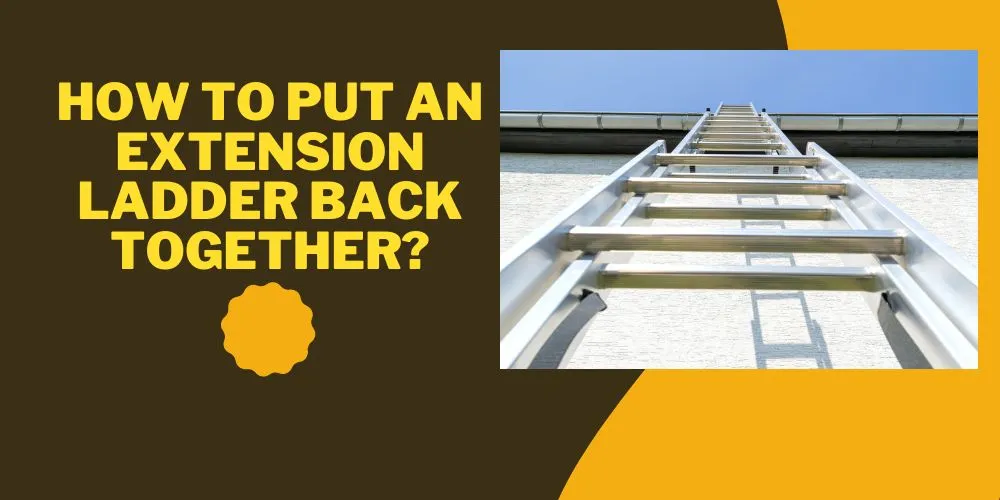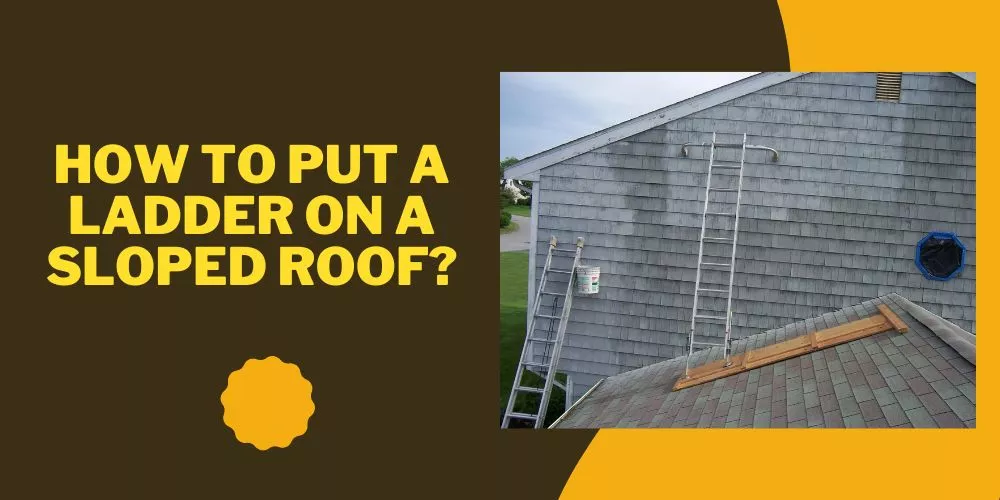Have you ever found yourself nervously balancing on a ladder, hoping it stays stable on uneven ground? If so, you’re not alone! Using a ladder on uneven terrain can be both tricky and risky, but it’s often necessary for many home improvement and maintenance tasks.
In this article, we’ll cover the essential tips and techniques to ensure your ladder remains safe, stable, and secure on uneven ground. We’ll explore the factors that contribute to ladder instability and the potential risks involved.
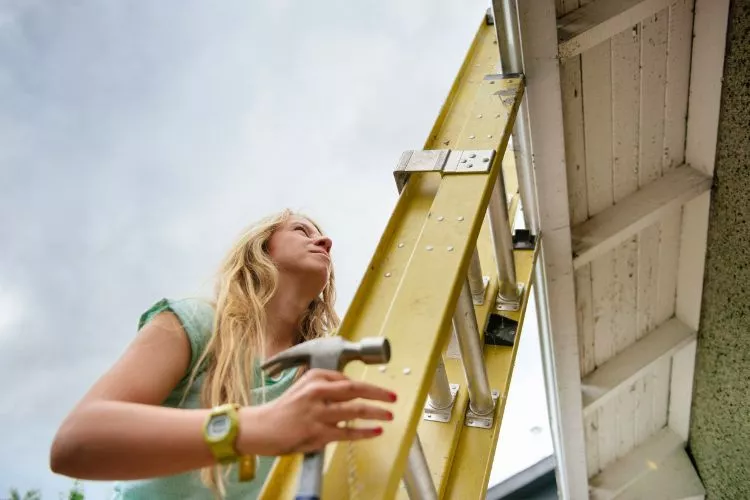
You’ll also discover the best types of ladders and accessories designed to help you confidently tackle any uneven surface. Let’s make sure your next climb is both safe and successful!
You’ll also learn about the different types of ladders and accessories designed to help you confidently tackle any uneven surface.
How to use a ladder on uneven ground? (Step-By-Step Process)
🪜Set Up the Ladder
Place the ladder on uneven ground, ensuring the feet are firmly planted on the surface. Check for any loose rocks, debris, or slippery surfaces that could cause the ladder to shift or slip.
If the ground is soft, use ladder stabilizers or place a wide, flat board under the feet to distribute the weight and prevent them from sinking.
Make sure the ladder is positioned at the proper angle, typically a 75-degree angle, with the base of the ladder approximately one-quarter of the ladder’s working length away from the wall or support.
🪜Adjust the Ladder
If you’re using an adjustable ladder, adjust the legs according to the slope of the ground. Extend or retract the legs on one side of the ladder until the rungs are level. Use a bubble level or a smartphone leveling app to ensure the ladder is level.
Double-check that all locking mechanisms are engaged and secure before climbing. Test the ladder’s stability by gently shaking it and confirming it doesn’t wobble or shift.
🪜Use Ladder Levelers (if available)
If your ladder has levelers, extend them to compensate for the uneven ground. Levelers are adjustable extensions that attach to the bottom of the ladder legs, allowing you to fine-tune the ladder’s height on each side.
Ensure the levelers are locked in place and the ladder stable before climbing. As with adjusting the ladder, use a bubble level or a smartphone leveling app to ensure the ladder is level and the rungs are parallel to the ground.
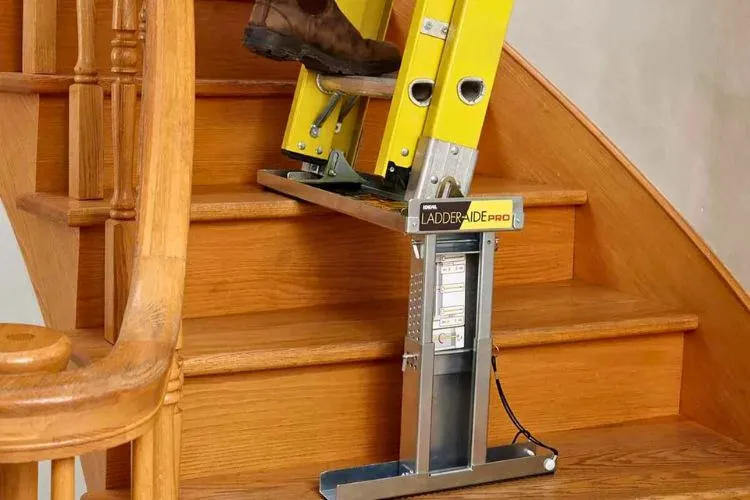
You can use several methods and tools to stabilize a ladder on uneven ground. Some of these methods include:
- Ladder levelers: These are adjustable extensions that attach to the bottom of the ladder legs, allowing you to fine-tune the ladder’s height on each side to level it on uneven ground.
- Ladder stabilizers: These devices attach to the ladder’s base, providing additional support and stability. They can help prevent the ladder from slipping or tipping over on uneven surfaces.
- Plywood or boards: Placing a wide, flat board under the feet of the ladder can help distribute the weight and provide a more stable base on soft or uneven ground.
- Ladder wedge or platform: A wedge-shaped platform can safely balance a ladder on sloped ground.
- Securing the ladder: Tying the top to a sturdy anchor point, such as a railing or structural beam, can help prevent the ladder from slipping or tipping over. Securing the bottom of the ladder using stakes or a ladder stabilizer bar can provide extra stability.
Always prioritize safety when using a ladder on uneven ground, and ensure that the ladder is stable and level before climbing.
🪜Secure the Ladder
To prevent the ladder from slipping, secure it at the top and bottom. Using rope or straps, you can tie the top of the ladder to a sturdy anchor point, such as a railing, post, or structural beam.
Make sure the knot or fastening is tight and secure. If possible, secure the bottom of the ladder by driving stakes into the ground and tying them to the ladder’s base or using a ladder stabilizer bar that attaches to the bottom rung and extends outward to provide additional support.
If these options are unavailable, have someone hold the ladder while you’re on it, ensuring they maintain a firm grip on the ladder’s sides and keep their feet planted on the ground.
Is there a ladder for uneven ground?
Yes, there are ladders designed specifically for uneven ground. Some options include adjustable leg ladders, articulated ladders, and ladder leveling accessories.
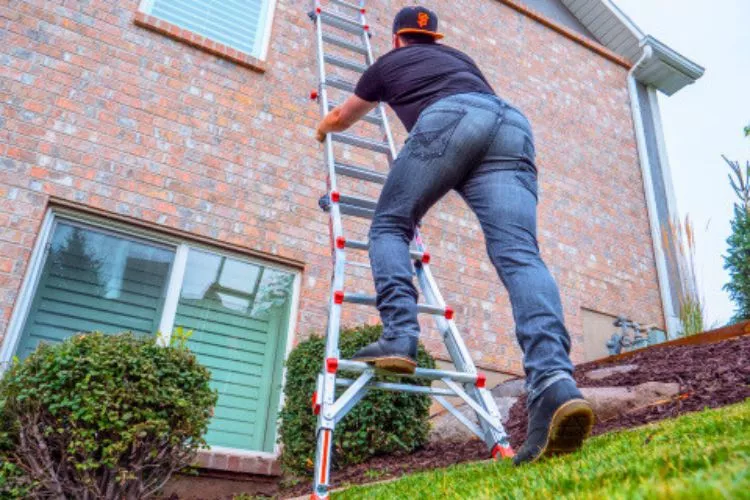
- Adjustable leg ladders: These ladders have legs that can be independently adjusted to accommodate uneven surfaces. They are often equipped with locking mechanisms to ensure stability and safety. One popular option is the Werner Equalizer Extension Ladder, which features adjustable legs and a built-in bubble level indicator.
- Articulated ladders: Also known as multi-position ladders, they can be configured in various ways, making them suitable for uneven ground. The Little Giant Ladder Systems M26 Velocity Ladder with Wheels is a versatile option for an A-frame, extension, 90-degree, or staircase ladder.
- Tripod ladders: Designed with three legs for stability, tripod ladders are ideal for working on uneven terrain or in tight spaces. They are commonly used in gardening and landscaping projects. The Henchman Platform Tripod Ladder is popular for its stability and adjustable legs.
When using a ladder on uneven ground, always ensure it is set up correctly and securely. Follow the manufacturer’s guidelines and safety precautions, and never exceed the ladder’s weight capacity.
How to use a Step ladder on a slope?
Using a step ladder on a slope can be challenging and potentially dangerous. However, there are some steps you can follow to ensure safety while using a step ladder on uneven terrain:
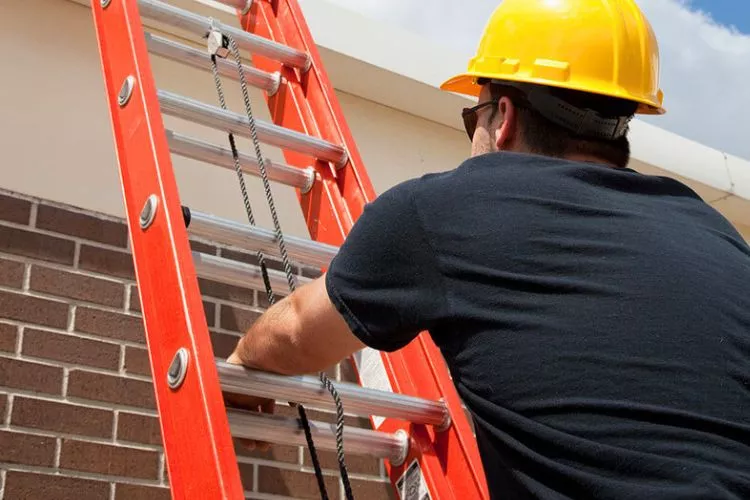
- Lashing the ladder: This method involves using a rope, cable, or ladder lashing kit to secure the ladder at a safe point, preventing it from falling or slipping while you climb.
- Use ladder levelers or adjustable legs: Some step ladders come with adjustable legs or levelers that can compensate for uneven ground and provide stability.
- Place the ladder on a stable base: If possible, use a wide, flat board or a ladder wedge/platform under the feet of the ladder to distribute weight and provide a more stable base on uneven ground.
- Maintain three points of contact: Always maintain three points of contact (two hands and one foot, or two feet and one hand) while climbing the ladder to ensure balance and stability.
- Follow general ladder safety guidelines: Set up the step ladder at the proper angle, ensure it is in good condition, and avoid overreaching or leaning too far to one side while on the ladder.
Remember that using a step ladder on a slope can be hazardous, and it’s essential to prioritize safety and stability when performing tasks on uneven ground.
Conclusion:
Using a ladder on the uneven ground presents unique challenges and potential dangers that must be addressed cautiously and properly.
You can significantly reduce the risk of accidents by selecting the right ladder for the task, ensuring it is in good condition, and utilizing appropriate tools and methods such as ladder levelers, stabilizers, and securing the ladder.
Always prioritize safety and follow general ladder safety guidelines, including maintaining three contact points and avoiding overreaching.
By taking these precautions and following the steps outlined in this article, you can confidently and safely use a ladder on uneven ground, ensuring a secure and stable working environment for all your t

